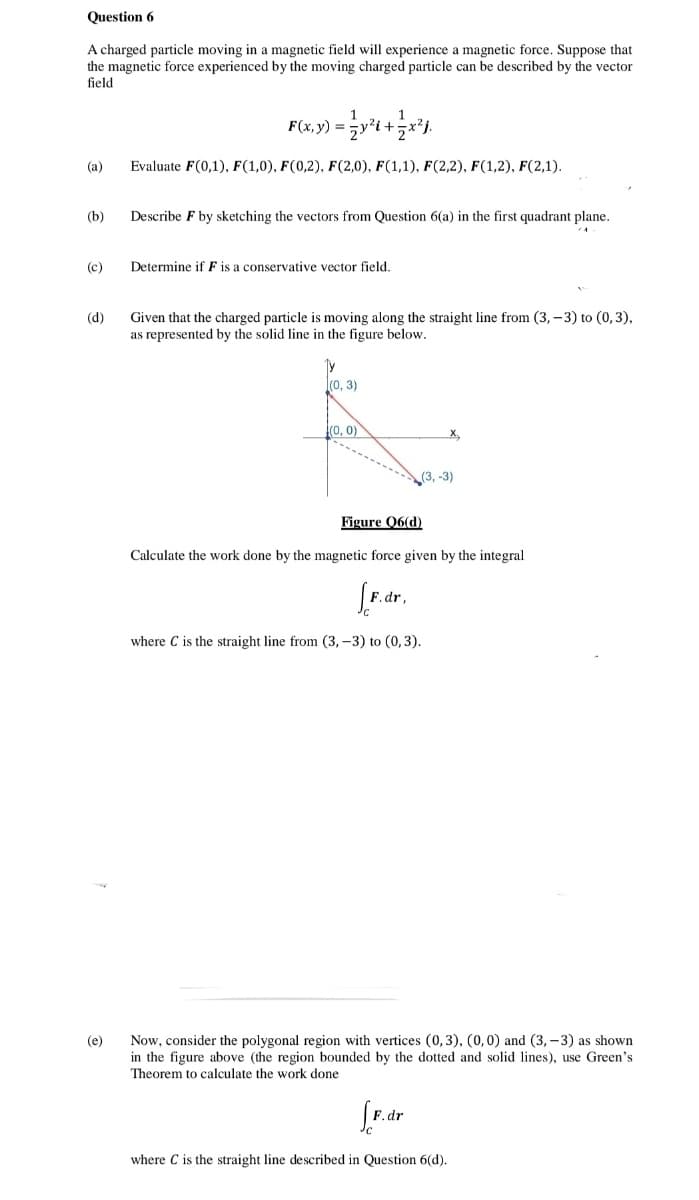A charged particle moving in a magnetic field will experience a magnetic force. Suppose that the magnetic force experienced by the moving charged particle can be described by the vector field F(x, y) (a) Evaluate F(0,1), F(1,0), F(0,2). F(2,0), F(1,1), F(2,2), F(1,2), F(2,1). (b) Describe F by sketching the vectors from Question 6(a) in the first quadrant plane.
A charged particle moving in a magnetic field will experience a magnetic force. Suppose that the magnetic force experienced by the moving charged particle can be described by the vector field F(x, y) (a) Evaluate F(0,1), F(1,0), F(0,2). F(2,0), F(1,1), F(2,2), F(1,2), F(2,1). (b) Describe F by sketching the vectors from Question 6(a) in the first quadrant plane.
Algebra & Trigonometry with Analytic Geometry
13th Edition
ISBN:9781133382119
Author:Swokowski
Publisher:Swokowski
Chapter8: Applications Of Trigonometry
Section8.4: The Dot Product
Problem 32E
Related questions
Question
Needed to be solved a and b part correctly in one hour please show neat and clean work

Transcribed Image Text:Question 6
A charged particle moving in a magnetic field will experience a magnetic force. Suppose that
the magnetic force experienced by the moving charged particle can be described by the vector
field
F(x, y) =
(a)
Evaluate F(0,1), F(1,0), F(0,2), F(2,0), F(1,1), F(2,2), F(1,2), F(2,1).
(b)
Describe F by sketching the vectors from Question 6(a) in the first quadrant plane.
(c)
Determine if F is a conservative vector field.
Given that the charged particle is moving along the straight line from (3, – 3) to (0,3),
as represented by the solid line in the figure below.
(d)
l(0, 3)
(0, 0)
X,
(3, -3)
Figure Q6(d)
Calculate the work done by the magnetic force given by the integral
F. dr,
where C is the straight line from (3, –3) to (0,3).
Now, consider the polygonal region with vertices (0, 3), (0,0) and (3, – 3) as shown
in the figure above (the region bounded by the dotted and solid lines), use Green's
Theorem to calculate the work done
(e)
.dr
where C is the straight line described in Question 6(d).
Expert Solution
This question has been solved!
Explore an expertly crafted, step-by-step solution for a thorough understanding of key concepts.
Step by step
Solved in 3 steps with 1 images

Recommended textbooks for you

Algebra & Trigonometry with Analytic Geometry
Algebra
ISBN:
9781133382119
Author:
Swokowski
Publisher:
Cengage

Algebra and Trigonometry (MindTap Course List)
Algebra
ISBN:
9781305071742
Author:
James Stewart, Lothar Redlin, Saleem Watson
Publisher:
Cengage Learning

College Algebra
Algebra
ISBN:
9781305115545
Author:
James Stewart, Lothar Redlin, Saleem Watson
Publisher:
Cengage Learning

Algebra & Trigonometry with Analytic Geometry
Algebra
ISBN:
9781133382119
Author:
Swokowski
Publisher:
Cengage

Algebra and Trigonometry (MindTap Course List)
Algebra
ISBN:
9781305071742
Author:
James Stewart, Lothar Redlin, Saleem Watson
Publisher:
Cengage Learning

College Algebra
Algebra
ISBN:
9781305115545
Author:
James Stewart, Lothar Redlin, Saleem Watson
Publisher:
Cengage Learning